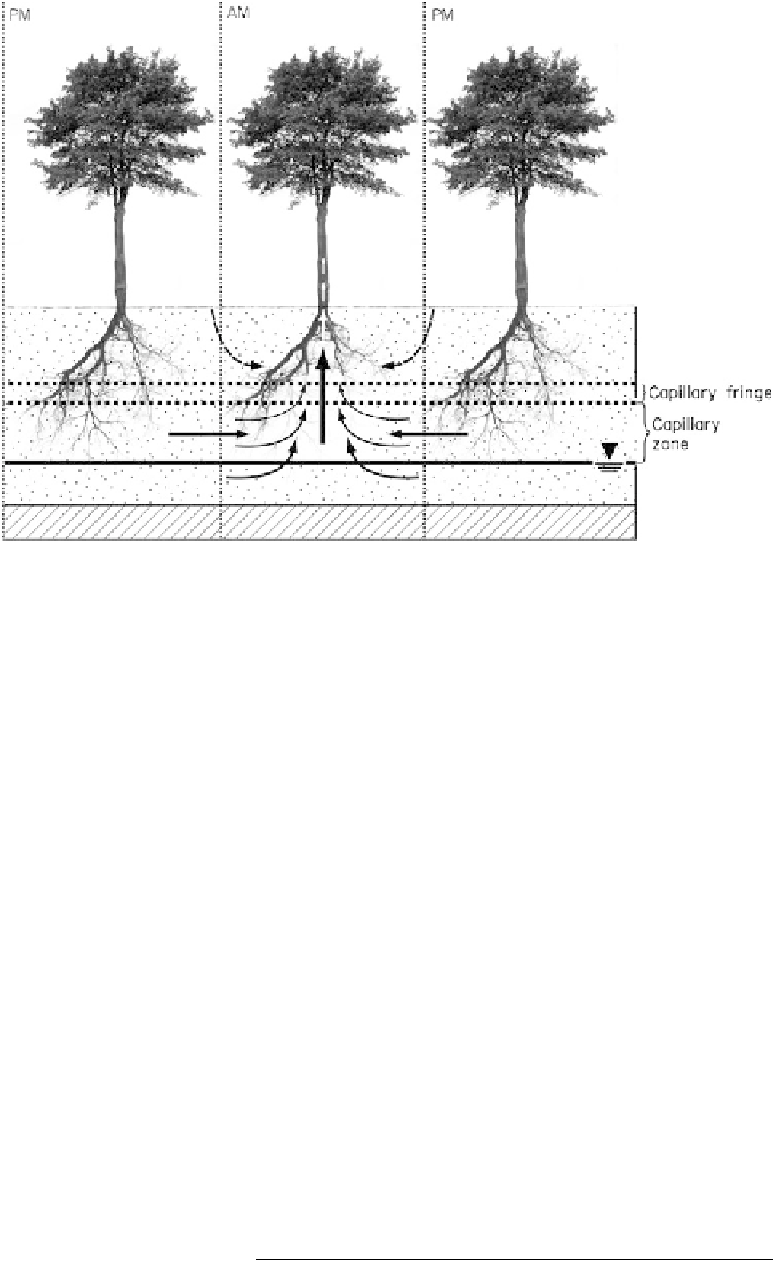Environmental Engineering Reference
In-Depth Information
Fig. 5.5
Possible sources of
water to plant roots in the
capillary fringe or zone (shown)
and water table and results
compared to time of day.
the riparian zone and the surface-water body on account of
water removed by
ET
. This decrease in gradient decreases the
flow of groundwater to surface water as indicated by a more
rapid decrease in surface-water levels. Gribovszki et al.
(2010) provide an excellent review of the interaction between
diurnal groundwater-level fluctuations and streamflow.
Other evidence that groundwater is used by trees can be
inferred by looking at the width of tree rings over time.
Although the relation to depth to groundwater is not apparent
initially, if a tree has tap roots its rings tend to be a consistent
width even during periods of little precipitation. On the other
hand, the width of tree rings is not consistent in plants that use
a less-consistent source of water (Douglass 1924).
Heuperman was able to demonstrate that groundwater levels
were lowered between 6.5 and 13 ft (2 and 4 m) relative to
control sites that did not contain plants. The groundwater
levels in a deeper aquifer, however, were not influenced.
Whereas groundwater flow was vertical downward previous
to planting, the transpiration of groundwater caused deeper
water to flow upward to the shallow aquifer and reversed the
vertical gradient. The hydraulic conductivity of the shallow
aquifer was about 1.6 ft/day (0.5 m/day). At these sites, the
deeper groundwater had higher salinity, and the upward flow
of saline groundwater toward the root zone resulted in a zone
of concentrated salts near the water table and capillary fringe.
Up to 80 sites in Australia were evaluated for plant and
groundwater interactions by George et al. (1999) who reported
that at the majority of sites, plants had no effect on the water
table; however, the sites that did affect the water table were
characterized by a considerably large planting. At some sites
investigated, the decreased water table could not be solely
attributed to the uptake of groundwater by plants, a decrease
in recharge by plant uptake, or both. A study by S´nchez-P´rez
et al. (2008) also found that hardwood trees growing in the
riparian zone of the Rhine River in France did not directly take
up water from the shallow water table at 3.3 ft (1 m) bls but,
rather, took up water in the unsaturated zone.
5.3.1 Plants and Groundwater Discharge
Trees affect groundwater levels by decreasing the pressure
head in the water table by direct root uptake or by abstracting
water from the groundwater table along a water potential
gradient. This can result in groundwater flow lines in the
saturated sediments some depth from the water table to
converge upward in response to the lower water levels and
pressures. If the soil and sediment hydraulic conductivity
were high enough and enough plants were present with high
transpiration rates under meteorological conditions that
would support evapotranspiration, such a plantation could
become a zone of groundwater discharge.
Heuperman (1999) investigated the relation between
phreatophytes and groundwater discharge at two sites in
Australia. Using
5.4
Plants and Groundwater Chemistry
The interaction between surface water and groundwater has
not always been clearly understood, as was demonstrated in
Chap. 2. It was probably not until the 1960s that it was more
groundwater-level monitoring
data,


Search WWH ::

Custom Search